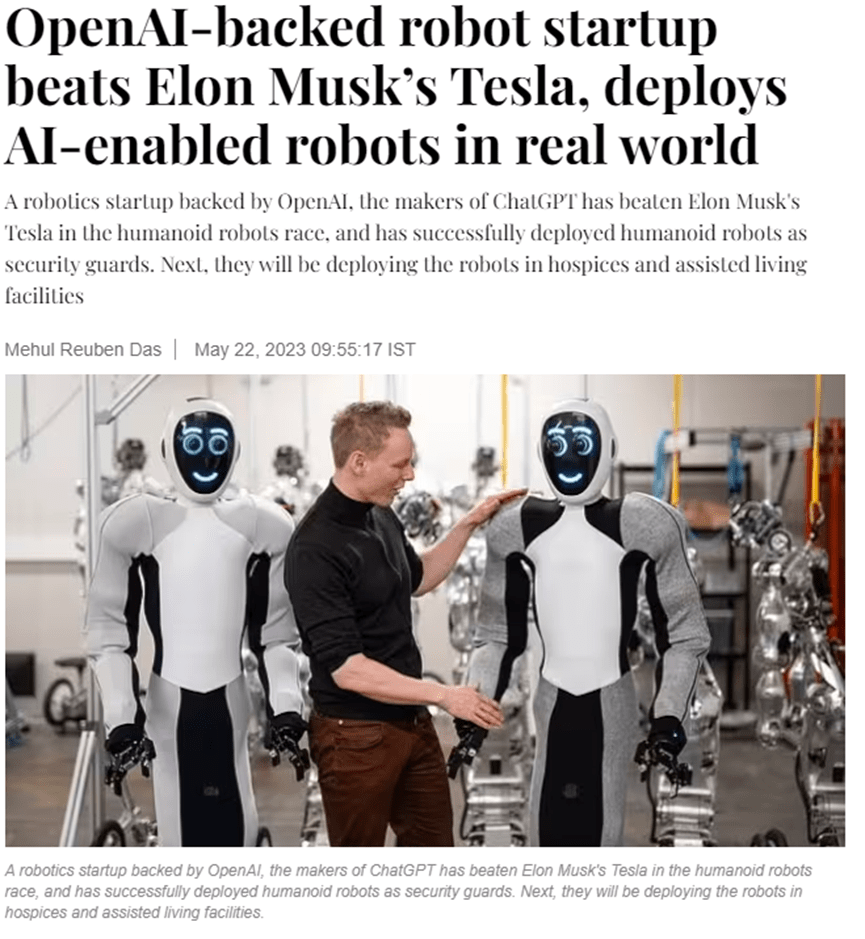
On May 22, Firstpost reported that EVE produced by 1x, a physical robot company supported by OpenAI, defeated Musk Tesla’s Optimus robot in a humanoid robot competition.
It is reported that some software functions of the EVE physical robot are supported by OpenAI’s ChatGPT, which means that ChatGPT can be materialized and applied in real-world business scenarios.
1X CEO and founder Bernt Bornich said that EVE’s humanoid robots have achieved a number of technological breakthroughs and applied them in actual business. Currently, EVE’s “humanoid robot security guards” have been deployed at two industrial sites. Unlike other robotic arms, these robots have heads, limbs, and even "emotions" that can communicate directly through the LED panels on their heads.

Staff will be able to control humanoid robots with virtual identities, much like the robots in the movie "Pacific Rim," when those robots malfunction.
EVE physical robot display
Bernt said that the purpose of creating 1x to build physical robots is to help the world solve the problem of labor shortage, especially in security, prisons, nursing homes and other fields. In the future, as operating costs rise and the birth rate continues to decline, there will be a serious shortage of security personnel in the United States. There are currently 1.1 million security personnel.
Bernt hopes that the EVE physical security robot built by 1x can achieve large-scale mass production in the next 5-10 years to make up for the problem of labor shortage. In addition to patrolling, EVE can also perform anthropomorphic operations such as opening doors, opening windows, and moving things. Most robots currently on the market do not have such a function.
OpenAI led a Series A2 funding round of $23.5 million for 1x on March 23rd this year. Halodi Robotics, now known as 1x, was founded in 2014 and is headquartered in Norway and has more than 60 employees.

Currently, 1x’s flagship robot EVE integrates VR, AI, intelligent navigation and other technologies, giving it powerful anthropomorphic execution capabilities, such as turning, opening doors, lifting objects, etc., which has been implemented in the security field Scenario implementation.
The EVE robot’s built-in automatic learning system can learn new actions through continuous action training. For example, when the robot is closing a window, if it encounters some obstacles during the closing process, it will try to avoid it next time. past these.
OpenAI’s investment intention is very obvious. They hope to carry out in-depth cooperation with 1x at the technical level. 1x is good at robot hardware technology, and OpenAI’s ChatGPT is popular all over the world. The combination of the two is bound to bring qualitative changes to physical robots and break through technical bottlenecks.
According to Firstpost reports, the physical robots supported by ChatGPT have already gained an advantage in the competition.
Musk introduces Optimus robot
The Optimus robot was launched by Tesla and its goal is to cooperate with Musk, the "Iron Man" of Silicon Valley. Optimus is also a humanoid robot with anthropomorphic abilities such as jumping, walking, and moving. It mainly applies Tesla's research results in the fields of autonomous vehicles, artificial intelligence, and battery technology.
Musk gave a detailed introduction to the Optimus robot at the 2023 Tesla shareholder meeting and stated that it will be mass-produced in the future.
Source of this article: AIGC Open Community, original title: "ChatGPT serves as a "security guard"! Musk’s Tesla robot was defeated by 1x powered by OpenAI! 》
The above is the detailed content of ChatGPT acts as a 'security guard'! Musk's Tesla robot was defeated by 1x powered by OpenAI!. For more information, please follow other related articles on the PHP Chinese website!




